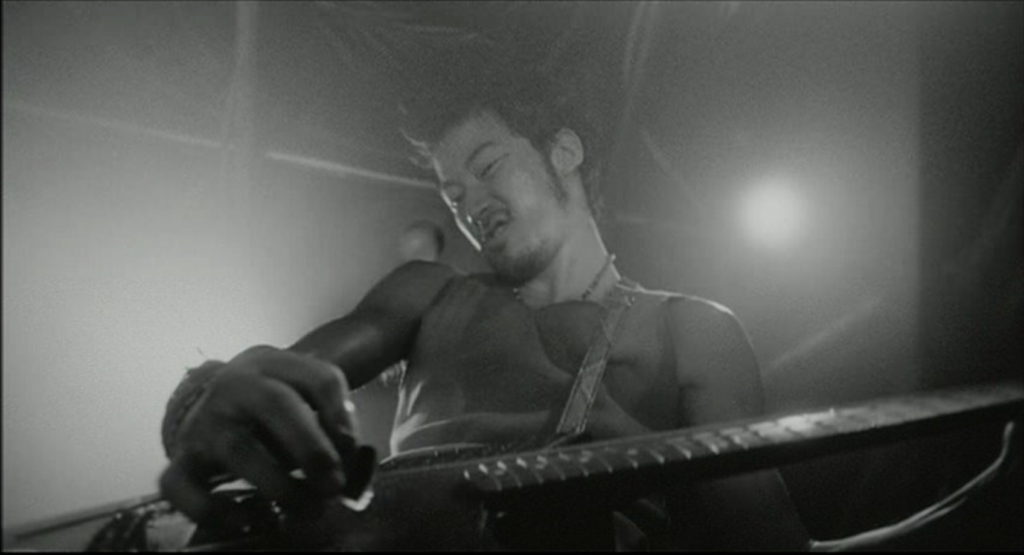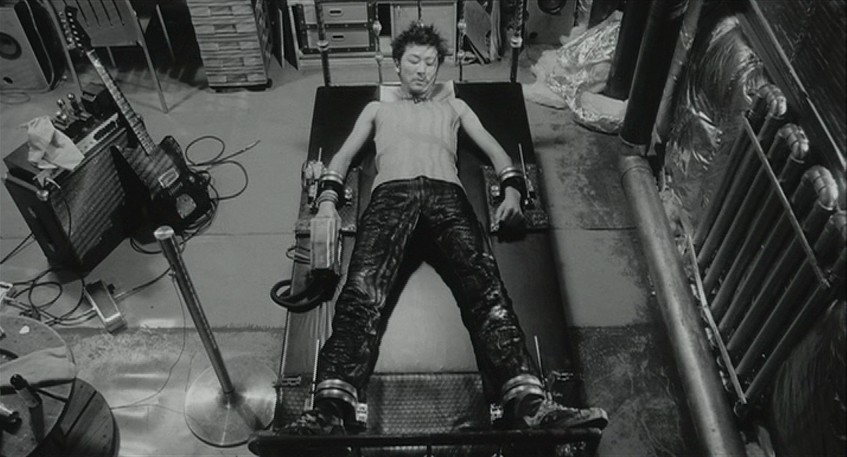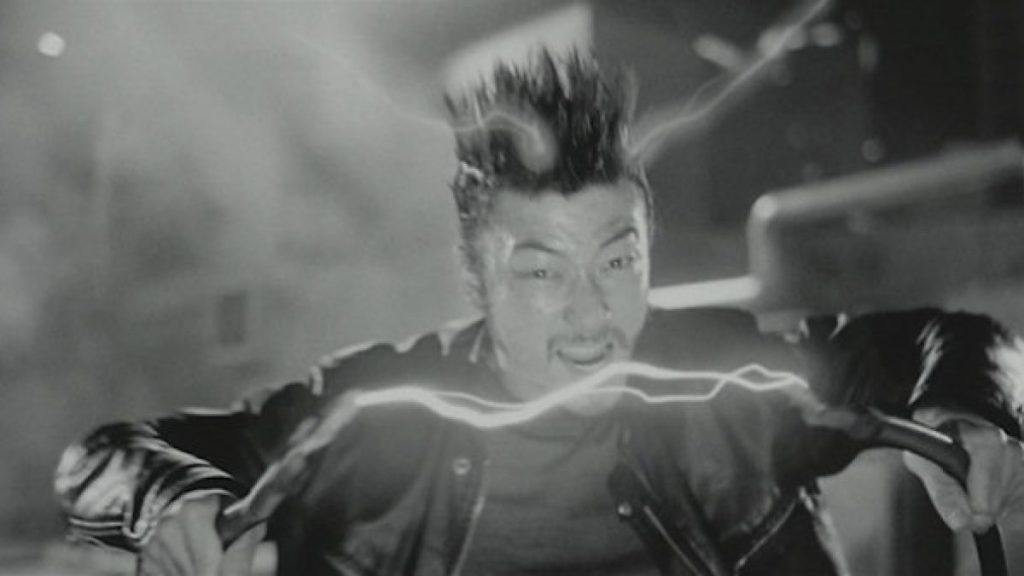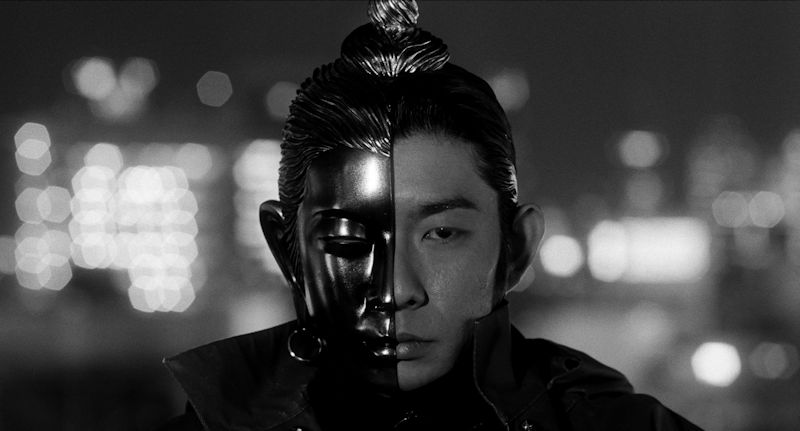Electric Dragon 80.000v
March 21, 2023 · 0 comments
By Tom Wilmot.

It wasn’t so long ago that Gakuryu Ishii was a somewhat obscure figure in the West, despite being one of Japan’s most influential modern filmmakers. However, with the director’s seminal punk films Crazy Thunder Road (1980) and Burst City (1982) receiving stacked Blu-ray releases in recent years, Ishii is experiencing something of a cultural resurgence. Third Window Films continues to celebrate this still underappreciated champion of Japanese underground cinema with a new release for one of his most beloved cult projects, Electric Dragon 80.000 V (2001).
The film follows Dragon Eye Morrison (Tadanobu Asano), a pet detective of sorts who spends his days searching for missing reptiles. A childhood accident unlocks an animalistic rage in Morrison, one that is quelled over the years through electroshock therapy, which eventually gives him the ability to conduct electricity. He’s discovered by TV repair man Thunderbolt Buddha (Masatoshi Nagase), a fellow electricity wielder who hunts local gangsters. Once the two men learn of each other’s existence, they race towards a shock-inducing showdown on the rooftops of Tokyo.

Released in 2001, when the director was still going by the name Sogo Ishii, Electric Dragon 80.000 V has often been hailed as a last hurrah for the Japanese cyberpunk movement. While the film certainly has elements of this distinct subgenre – an oppressive urban setting and cybernetic enhancements – it shares more in common with its creator’s madcap punk projects of the 1980s. The more meditative filmmaking approach cultivated by Ishii through his 1990s projects is thrown to the wind here, as the director returns to the frantic camera work and noisy, audio-visual onslaught utilised for the mind-blowing Burst City. The film’s only real carryover from Ishii’s contemporary work is the aesthetic choice to shoot in black and white, which was also used to full effect for Labyrinth of Dreams (1997).
The film’s 55-minute-long narrative meanders in moments. Morrison wanders the streets of Tokyo, ducking into every nook and cranny on the lookout for lost lizards. Meanwhile, Thunderbolt Buddha eavesdrops on Tokyo’s most conspicuously dressed gangster, waiting to strike once their guard is down. Once the two electrically charged superhumans catch wind of each other, all roads lead to a scintillating final fight that doesn’t disappoint. For such a meagrely-budgeted film, Electric Dragon’s finale presents a confrontation of epic proportions. The grand duel, contested through an electrifying fistfight, wouldn’t feel out of place in a shonen anime, as Morrison and Buddha unleash a series of devastating attacks, draining nearby power sources to charge up their abilities on the fly. It doesn’t hurt that the two characters have larger than life appearances, particularly Thunderbolt Buddha, whose magnificent costume makes for an iconic look. The film’s storyboards, which are included with Third Window’s release, aren’t too dissimilar from the panels you’d find in a manga, and they’re faithfully realised on the screen.

Although an off-the-wall and experimental project, Electric Dragon actually demonstrates Ishii’s continued growth and maturity as a director. While Burst City’s abrasive visual style is the result of an anarchic production helmed by a young and relatively inexperienced filmmaker, Electric Dragon’s kinetic visuals are calculated and purposeful. The use of Ishii’s trademark fast-motion works brilliantly to build anticipation for the final fight, while the integration of stylised graphics brings the characters’ electrifying powers to life. These in-your-face visuals are juxtaposed with moody shots of an overcast Tokyo landscape and a few instances of stark and quite disturbing imagery. Although not as raw as the director’s earlier works, the film builds on his early punk sensibilities and form to give the impression of a measured director whose skill has developed with age.
While Ishii’s more meditative works during the 1990s no doubt informed his approach to Electric Dragon to a degree, the project also owes a debt to the director’s concert films of the 1980s. In the long decade between The Crazy Family (1984) and Angel Dust (1994), Ishii collaborated with several bands, including the Japanese punk outfit The Roosters and the German underground band Einstürzende Neubauten, producing experimental concert films for them both. Ishii’s ability to present the act of playing music in such an exciting and filmic manner lends itself to Electric Dragon, as Morrison thrashes a guitar to channel his rage. In fact, the film is more intimately rooted in Ishii’s love for music than one might first guess. The director and lead actor Tadanobu Asano, who had previously collaborated on Labyrinth of Dreams, made up half of the band Mach 1.67. The group’s intense industrial punk music inspired the creation of Electric Dragon in the first place, and they went on to produce the film’s heavy-hitting score.

An impromptu project, Electric Dragon was completed in a very short time frame, conceived and shot whilst Ishii was in the process of preparing for Gojoe (2000), another Asano vehicle. In undertaking the project, Ishii once again embodied the do-it-yourself attitude of both Japan’s punk and jishu eiga (self-made film) scenes. Straying from the norms of the film industry further still, the director once toyed with taking the film on tour concert-style rather than heading down a typical distribution route. While his style and forename have changed over the years, Ishii remains a staunchly rebellious and fiercely independent filmmaker; his attitudes are typified by the uniqueness of Electric Dragon.
Alongside several archival extras on this Third Window release is a new interview with former Mach 1.67 member Hiroyuki Onogawa. The composer has been producing film scores for the better part of thirty years, and he got his start in the industry through a chance meeting with Ishii at a bar in Fukuoka. Beginning with Ishii’s August in the Water (1995), Onogawa would go on to work almost exclusively with the director until Mirrored Mind (2004), which marks their last collaboration to date. Coming from a background in ambient music, the composer notes that he’s mostly associated with rock music in Japan due to his work on Electric Dragon. In this insightful interview, Onogawa traces his career through the film industry and discusses the short-lived life of Mach 1.67.
A Blu-ray release for Electric Dragon 80.000 V has been long overdue, and Third Window Films’ package doesn’t disappoint. In terms of essential Japanese cult films, Ishii’s wild project should be pretty high on everyone’s watchlist. So, strap yourself in, crank up the volume, and immerse yourself in this utterly electrifying piece of punk cinema from one of Japan’s finest modern filmmakers.
Electric Dragon 80.000 V is released in the UK by Third Window Films.
Leave a Reply